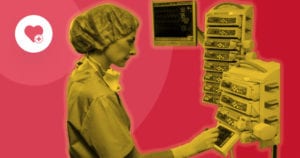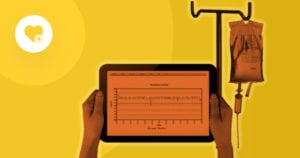
Today, AI delivers immediate benefit in automating defined and repeatable tasks when there are large amounts of data to consider. This makes it particularly appealing within healthcare, where both new volumes of data are generated daily and there are many repeated, well-defined and routine tasks conducted. AI currently can replicate tasks that are “humanly possible” but time-consuming, repetitive and potentially prone to human error.
While safe and effective, AI in healthcare is still in its infancy, but we’re starting to see the industry make great strides. Here are just a few ways AI is already helping to streamline workflows and to improve healthcare processes.
Converting Data into Actionable Information
The human body generates an immense amount of internal data. Collecting vital signs, lab test results, written notes and imaging data from patients are key elements to making good clinical decisions during care. Combining this with other potentially relevant lifelong health data, such as visits, diagnoses, prescriptions, and self-reported symptoms, and multiplying this data over vast populations, makes this a task of dizzying proportions. In 2015, in the U.S., there were 991 million physician office visits. There are simply not enough doctors in the world to analyze all the information being generated as quickly as it could make a difference.
When we meet with health systems, the number one area of interest for executives is data. Everyone wants data to support and to develop intuition. There is little point in collecting data if it cannot be used to improve healthcare or healthcare delivery. Thankfully, AI is capable of analyzing vast data sets to derive actionable insights professionals can use to make earlier and more informed decisions.
Some of the signals and patterns within these data sets are either too subtle for the human eye or they need to be characterized across a vast scale of data to be truly representative and valuable. We still have little understanding of how these patterns relate to future outcomes because we have been incapable of collecting this data or analyzing it at scale, but that is changing.
With enough training data and labels, deep learning allows for the recognition of patterns that would be incomprehensible to humans. AI allows for massive computational capacity to learn patterns across many tens of thousands of patients. This will let doctors react faster and address a health event before it becomes critical.
Enter the Internet of Medical Things (IoMT)
Previously, only in the ICU was it possible to continuously monitor patients. ICU monitors, with their many leads and wires, weren’t feasible in general medical and surgical units and other lower-acuity environments. In these environments, vital sign collection was restricted to every four hours or so, with deterioration often unnoticed until the next check. Risk stratification was only possible using general EMR or other infrequent data. That means the risk stratification can only ever be as good and timely as the data that’s collected manually.
This has changed. With today’s connectivity options, wireless monitoring devices that fit comfortably on a patient’s arm can now deliver ICU-caliber health data continuously to care teams in a way that is practical for lower acuity environments.
While there are only a small number of patients in ICU, there are exponentially more in low acuity areas, such as general medical and surgical units. Thus, simply generating data is unlikely to solve the problem—there are not enough doctors in the hospital to handle this amount of data.
Again, this is where AI becomes a powerful ally. AI provides instant and continuous evaluation of health data to identify the patients who may be deteriorating. This allows better utilization of our healthcare professionals, who can instead focus their time on the patients who need them the most.
Remote patient monitoring (RPM) devices are a key aid to physicians and care teams. Detecting the health deterioration of a patient in the hospital faster has the potential to greatly reduce the number of patients who are discharged prematurely, only to be readmitted soon after for the same condition. Hospital readmission is currently a $40 billion problem in the United States.
Proactive Vs. Reactive Care: AI in the Home
As healthcare resources become more strained and as our population ages and grows sicker, providers are seeking new models that allow for the delivery of more health and care at home. Hospitals are becoming quaternary treatment centers with shorter lengths of stay, and every health system wants to minimize readmissions and costly unplanned ER visits.
To enable this, we must be able to identify which patients can safely be treated as outpatients, which will develop sepsis, and which require treatment or not. The development of AI models to predict these outcomes, with extremely high sensitivity and specificity, will completely reshape our healthcare system.
Remote patient monitoring devices let patients enjoy the comfort and familiarity of their own home instead of a hospital bed while feeling safe knowing there’s someone keeping an eye on them. Previously, once patients left the hospital, it was almost impossible to monitor their health. Many patients don’t call their doctor until well after the earliest symptoms have started and their condition has worsened.
With RPM, vital signs and other health data are passively collected from the patient and sent to the cloud where AI models can alert appropriate healthcare professionals if the person starts to become unwell. This ability to manage throughput—to separate the signal from the noise—is the power of AI. It lets healthcare professionals focus on the patients who need their attention the most, and it helps those who don’t need healthcare attention feel safer and more secure at home. Many patients simply require the reassurance that everything is OK and is going to be OK.
The early-detection capabilities enabled by AI’s analysis of health data, which is continuously captured from these remote monitoring devices, lets healthcare professionals shift from reactive to proactive care. The best way to reduce healthcare costs is to treat at a lower acuity and a lower cost point. That means treating patients before they turn up at the ER and before they require readmission.
For the foreseeable future, AI will have a significant role in improving healthcare throughput, helping better deploy our limited healthcare resources to the patients who most need attention and delivering it at an earlier point. However, while the promises of AI and IoT are high, a computer has no emotion. This is the power of computation but also its weakness. Healthcare professionals are an essential part of healthcare delivery; they are the ones who turn information into action. Often, a decision required has to do with what not to do, and much information is subjective and can only be elicited through real human contact.
It is currently impossible for AI to replace a human’s intuition and ability to see outside the box and discern an outcome. However, tools like AI will help fundamentally reshape how we deliver healthcare, and it will improve the lives of patients, doctors and other healthcare professionals in a way that is economically sustainable.
While already enhancing patient care and improving clinical processes, the industry has only begun to scratch the surface.





 Related Podcast Episode
Related Podcast Episode




 Related Applications
Related Applications



 Latest IoT News
Latest IoT News







